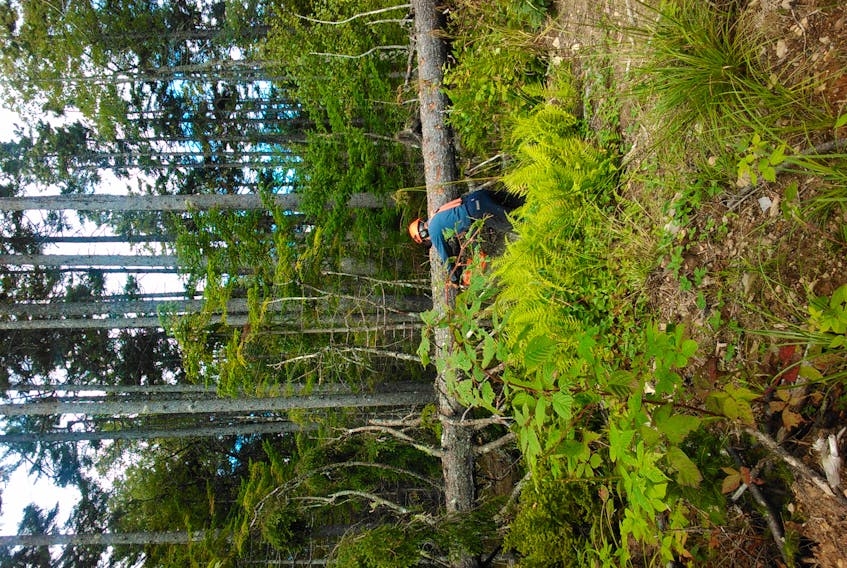SPENCERS ISLAND, N.S. — Hurricane Dorian was a storm Peter Spicer won’t soon forget.
The Spencer’s Island man owns a private woodlot near Advocate Harbour that was pummeled by the storm.
“If I had to estimate I’d say I lost hundreds of trees,” Spicer told the Amherst News.
A retired teacher, Spicer operates a 650-hectare woodlot that has been in the family for many years. He’d hear stories from his late father, Max, about hurricane Edna in 1954 and the damage did, but he never expected another hurricane would hit him with the force of Dorian.
“It’s the worst I’ve ever experienced,” said Spicer of the impact on his company, Seven Gulches Wood Products. “Right now, I’m dealing with a lot of blowdowns. Trees are scattered everywhere and it’s pretty dangerous work because I don’t have a harvester. I have to go in and cut them. I have hundreds of them and it’s going to take me a couple of months to clean it up.
“Hopefully no other hurricanes come around. There are trees hanging and you have to get the ones leaning over before you can get the ones under. I’ve been doing that since the day after the hurricane.”
Spicer said it will damage his company for a few years, but it’s not something he can’t overcome.
Although some areas of Cumberland County and Nova Scotia received large amounts of rain from Dorian, Spicer said it was more wind damage. However, he added, the remnants of tropical storm Erin dumped in excess of 150 mm of rain the week before Dorian, washing out some of his trails and weakening trees.
Spicer said he has someone who has been helping him in areas where there are multiple trees. He does not want to leave the trees lying around because some are blocking his woods roads, but in other cases he’s concerned about the potential for pine beetle infestation and fire.
“This is going to change my management plan. You can’t leave hundred-trees lying around because you lose the money but you also run the risk bark beetle that’s around old-growth timber and it can be devastating,” Spicer said. “If you leave these blowdowns in the next couple of years you’re going to have some problems, so I’m going to harvest until the snow makes it difficult to do.”
Craig Tupper, forester for the Athol Forestry Co-operative, said the damage in other areas is more moderate, although some were harder hit than others.
“I saw almost as much damage from the storm last fall as this one. There were some mature spruce stands that were hit harder than others. It depended where they were and what soil they were on,” Tupper said. “Overall the damage was light, considering what we had. Poplar and unmanaged stands saw more damage than in our managed stands because we’ve done a lot of selective harvesting and commercial thinning the last few years. I was nervous coming back on Monday after the storm expecting to see a lot of damage. Yes there were some blowdowns, but it wasn’t catastrophic.”
Along the north shore, Greg Nix is involved with various trails association including Cumberland Trails, the Route 6 Trail and Oxford trails associations. He said there was lots of damage to the entire trail network.
“It seemed to be some areas were hit harder than others,” Nix said. “The damage on the Great Trail between Oxford and Tatamagouche was loaded with trees down and the spur line to the trail had 60 or 70-feet trees down. We’ve had a lot of volunteers out with power saws and ATVs punching holes through it.”
While some of this damage, including trees toppled over onto the trails, most of it has been cleared thanks to volunteers. Some work, however, is going to take longer and cost a lot of money. In a couple of areas, large culverts were washed out, making the trails impassible. Some have been fixed, but there are a couple that will be a challenge to repair.
It compounded damage done by a 100-mm rainfall in early July.
Nix said the groups will be applying for funding to help with repairs and is accepting donations. He said there is equipment and materials the groups don’t have like a high-hoe and specialized gravel included in replacing British culverts.
“The goal is to get the culvert from Oxford to Tatamagouche opened as soon as possible,” he said.
The other issue is the damaged culverts could cause issues with surrounding landowners in the form of flooding should another storm occur.
Nix, who lives in West Pugwash, said he lost three trees around his house, one of which hit the house. There was also damage along the shoreline.









